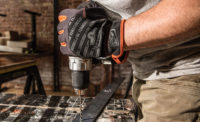Particularly in an industrial environment, whether the application is food processing, automotive or lab work, gloves must withstand a wide range of challenging physical demands. And with many products on the market to choose from, informed purchasers are increasingly interested in knowing the science and technology behind the manufacturing of the glove.
Most of what to look for in a quality glove choice isn’t apparent by just trying it on. The fact is, not all gloves are made the same way. And the process by which a glove is made has a lot to do with the integrity of the final product.
Let’s look at several important material features and manufacturing processes users may want to discuss with potential glove providers before deciding which product is best for their application:
Chlorination
Chlorination is an effective method for making gloves safer, better performing and more comfortable. Chlorination reduces the high degree of “tack†or friction on the outer surface of gloves made from natural rubber latex (latex). The process works by having the outer surfaces of the glove come into contact with free chlorine. This causes the glove to become very smooth and easy to don. Chlorination also hardens the glove’s outer surfaces, adding to its barrier properties.Chlorination also contributes to “cleaning†gloves of residual chemicals used in the manufacturing process and removing water-soluble extractable proteins from latex, which studies have claimed to be the most common contributors to adverse reactions experienced by latex-sensitive individuals. Chlorination has the effect of chemically denaturing proteins, a chemical reaction that occurs which has the potential to change the functionality of proteins, making them insoluble. In other words, proteins that were previously water-soluble are chemically changed and are now not soluble in water.
To date, studies suggest that chlorination is the most effective powder-free process that reduces the level of total extractable protein.
Polymer coating
A polymer coating eases the donning and removal of a thin-film glove. Polymer coatings are applied to the inside of a glove during manufacturing to aid in the “donability†of gloves in wet or dry conditions. Polymer coatings may also be applied to the exterior surface of the glove as a detacktifying agent. To date, polymer coatings do not add additional barrier properties to a thin-film glove.Many conventional polymer coatings used on gloves today are only partially effective because they don’t have the same elasticity of the glove material to which they are applied. So as the glove material stretches (as in donning), the polymer coating does not always stretch with it. These differing polymers can delaminate, or separate, from the glove material, thereby causing flaking of the polymer coating from the interior and/or exterior of the glove.
Advanced polymer formulations and adhesion methods provide far better adhesion properties to the glove material and are very effective in overcoming the difficulties of damp and wet hand donning, as well as the potential for gloves to stick or “block†in the box.
The combination of chlorination and a polymer coating — a process only a few manufacturers are able to perform — results in an optimal balance of both tactile sensitivity and durability.
Residual chemicals
In glove manufacturing, a variety of chemicals may be used to accelerate the curing of latex and nitrile materials. While quality manufacturing lines consume most of these chemicals in the process, some residual amounts of these chemicals remain. Most of the remaining chemicals are leached, or washed from the finished product through multiple leaching cycles.The more effective the leaching system, the lower the amount of residual chemicals that will remain on the finished product. Quality systems utilizing multiple washes and more sophisticated agitation systems (counterflows and sonication) are most effective. Chlorinated products have the added benefit of chlorine’s ability to effectively remove residual chemicals and chemical by-products.
Quality manufacturers monitor trace amounts of residual chemicals in their products and can provide measurement data on request.
Beyond basics
When choosing protective gloves, safety pros must insist that their supplier know more than just the “basics.†A thorough understanding by the manufacturer of how gloves are made, what physical, barrier protection and chemical composition properties they have, and the science that goes into those properties is essential.The relationship between the glove supplier and buyer has never been more critical, as the decision to purchase gloves requires a thorough understanding of the consumer’s needs, technical data, appropriate applications and the science involved in the manufacture of gloves.

